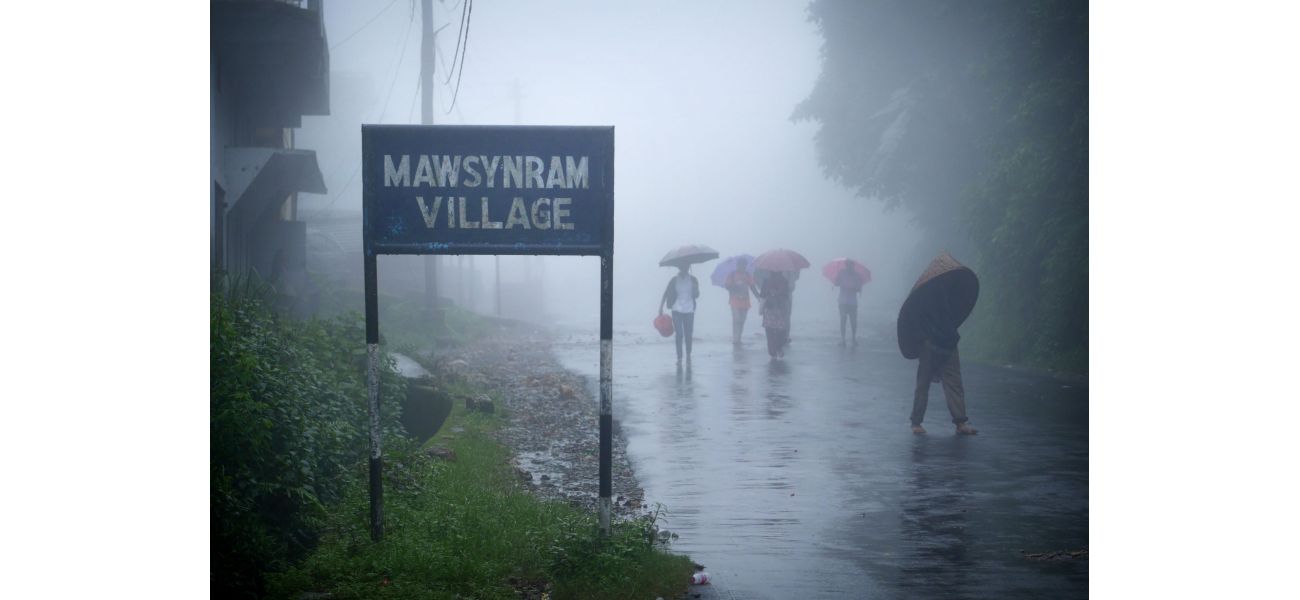The wettest spot on Earth where people live in stilt houses and use full-body umbrellas.
Worse than London.
October 17th 2024.

Mawsynram, a small village located in the northeastern state of Meghalaya, India, holds the impressive title of being the rainiest place in the world. While the UK may be known for its rainy weather, the heavy showers there are nothing compared to the relentless downpours that residents of Mawsynram endure on a daily basis. Nestled among the lush green forests of the Khasi Hills, this village receives an average annual rainfall of 11,872mm, which is over 20 times more than the annual rainfall in London.
Despite the challenging living conditions, Mawsynram is home to around 4,000 residents who have adapted to the remarkably soggy environment. The monsoon season, from June to September, brings torrential rain that can keep residents confined to their homes for weeks at a time. However, the villagers have come up with unique ways to cope, from soundproofing their homes to making special shell-like umbrellas. This village has also become an unlikely tourist destination, with adventurous travelers flocking to admire its stunning scenery.
When it comes to the weather in Mawsynram, it is unlike that of most places. The rain here doesn't just come and go; when it starts, it can last for weeks on end. The village receives approximately 11,872mm of rainfall each year, which is about 20 times more than what London receives. The peak of this rainfall occurs during the monsoon season, with the heaviest downpours happening in June. In fact, in June 2022, Mawsynram recorded a staggering 1,004mm of rain in just one day, which is about twice as much as London receives in an entire year.
Despite the constant rain, the village experiences a brief "dry" period from December to February, with an average monthly precipitation of only 60mm. The rest of the year, the average monthly temperatures range from 10C in January to just over 20C in August. Its neighboring village, Cherrapunji, is also known for its heavy rainfall, receiving an average of 11,777mm per year.
The extreme rainfall in Mawsynram is due to its geographical location and topography. The village sits on the edge of the high Shillong Plateau, which rises approximately 1,400 meters above sea level. This elevation creates a unique highland climate and acts as a barrier to the monsoon winds blowing in from the Bay of Bengal. As the winds encounter the Khasi Hills, they are forced to rise, leading to cool and condensed air, and significant rainfall. This phenomenon, known as the Orographic Effect, plays a significant role in the region's high rainfall.
Living in Mawsynram can be challenging, with residents often confined to their homes for days or even weeks due to the relentless rain. To cope with this extreme weather, the villagers make careful preparations before the rainy season arrives. They use natural materials like thick bamboo, grass, or thatch to soundproof their homes, and many houses are built on stilts or raised foundations to protect against flooding. Additionally, residents stockpile food and firewood to ensure they have enough resources to last them through the monsoon season.
Special rain covers called knups also play a crucial role in daily life in Mawsynram. These traditional, full-body umbrella-like shields are made from bamboo, plastic sheets, and banana leaves and are used to protect from heavy downpours. The process of making a knup is long and takes at least an hour to complete, with women in the village spending their time crafting them during the rainy season.
Despite its reputation as the world's wettest village, Mawsynram has become quite the tourist attraction. The nearest airport is Shillong Airport, about 86 kilometers away, and from there, tourists can take a cab or bus to the village, which takes about three hours. Along the way, they can enjoy the beautiful scenery of lush green hills and valleys. Accommodation options in the village are limited, but there are several guesthouses and homestays available. Another option is to stay in the nearby village of Cherrapunji, only 5km away.
Besides experiencing the unique weather, tourists can also visit various sites in the region. One of the main attractions is Krem Puri, the largest sandstone cave in the world, which is only a 15-minute drive from Mawsynram. The area is also home to picturesque waterfalls, such as the Kynrem Falls and Nohkalikai Falls, known as one of the wettest places on earth. Additionally, tourists can visit the giant living root bridges, a UNESCO World Heritage Site, where bridges are made of intertwined roots in the East Khasi Hills.
Do you have a story to share about your experience in Mawsynram? We would love to hear it! Get in touch by emailing us at email.
Despite the challenging living conditions, Mawsynram is home to around 4,000 residents who have adapted to the remarkably soggy environment. The monsoon season, from June to September, brings torrential rain that can keep residents confined to their homes for weeks at a time. However, the villagers have come up with unique ways to cope, from soundproofing their homes to making special shell-like umbrellas. This village has also become an unlikely tourist destination, with adventurous travelers flocking to admire its stunning scenery.
When it comes to the weather in Mawsynram, it is unlike that of most places. The rain here doesn't just come and go; when it starts, it can last for weeks on end. The village receives approximately 11,872mm of rainfall each year, which is about 20 times more than what London receives. The peak of this rainfall occurs during the monsoon season, with the heaviest downpours happening in June. In fact, in June 2022, Mawsynram recorded a staggering 1,004mm of rain in just one day, which is about twice as much as London receives in an entire year.
Despite the constant rain, the village experiences a brief "dry" period from December to February, with an average monthly precipitation of only 60mm. The rest of the year, the average monthly temperatures range from 10C in January to just over 20C in August. Its neighboring village, Cherrapunji, is also known for its heavy rainfall, receiving an average of 11,777mm per year.
The extreme rainfall in Mawsynram is due to its geographical location and topography. The village sits on the edge of the high Shillong Plateau, which rises approximately 1,400 meters above sea level. This elevation creates a unique highland climate and acts as a barrier to the monsoon winds blowing in from the Bay of Bengal. As the winds encounter the Khasi Hills, they are forced to rise, leading to cool and condensed air, and significant rainfall. This phenomenon, known as the Orographic Effect, plays a significant role in the region's high rainfall.
Living in Mawsynram can be challenging, with residents often confined to their homes for days or even weeks due to the relentless rain. To cope with this extreme weather, the villagers make careful preparations before the rainy season arrives. They use natural materials like thick bamboo, grass, or thatch to soundproof their homes, and many houses are built on stilts or raised foundations to protect against flooding. Additionally, residents stockpile food and firewood to ensure they have enough resources to last them through the monsoon season.
Special rain covers called knups also play a crucial role in daily life in Mawsynram. These traditional, full-body umbrella-like shields are made from bamboo, plastic sheets, and banana leaves and are used to protect from heavy downpours. The process of making a knup is long and takes at least an hour to complete, with women in the village spending their time crafting them during the rainy season.
Despite its reputation as the world's wettest village, Mawsynram has become quite the tourist attraction. The nearest airport is Shillong Airport, about 86 kilometers away, and from there, tourists can take a cab or bus to the village, which takes about three hours. Along the way, they can enjoy the beautiful scenery of lush green hills and valleys. Accommodation options in the village are limited, but there are several guesthouses and homestays available. Another option is to stay in the nearby village of Cherrapunji, only 5km away.
Besides experiencing the unique weather, tourists can also visit various sites in the region. One of the main attractions is Krem Puri, the largest sandstone cave in the world, which is only a 15-minute drive from Mawsynram. The area is also home to picturesque waterfalls, such as the Kynrem Falls and Nohkalikai Falls, known as one of the wettest places on earth. Additionally, tourists can visit the giant living root bridges, a UNESCO World Heritage Site, where bridges are made of intertwined roots in the East Khasi Hills.
Do you have a story to share about your experience in Mawsynram? We would love to hear it! Get in touch by emailing us at email.
[This article has been trending online recently and has been generated with AI. Your feed is customized.]
[Generative AI is experimental.]
0
0
Submit Comment





